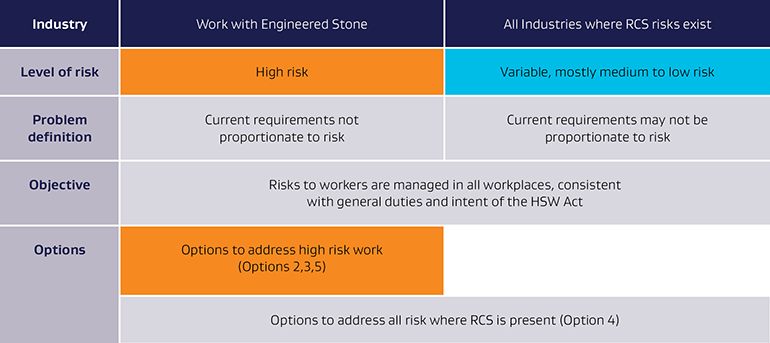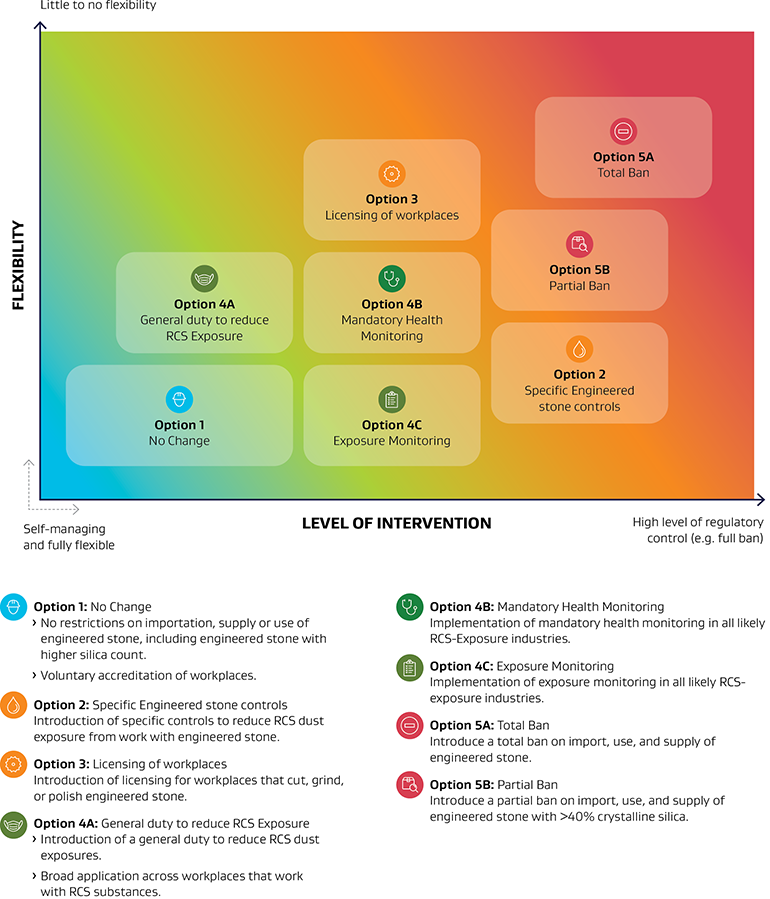Options for working with engineered stone and materials containing crystalline silica
Our main objective is to ensure PCBUs minimise worker exposure to RCS so far as is reasonably practicable.
On this page
The primary objective is that RCS risks to workers are managed in all workplaces, consistent with the general duties and intent of the HSW Act. The HSW Act places a duty on PCBUs to ensure, so far as is reasonably practicable, the health and safety of workers who work for the PCBU, and workers whose activities in carrying out the work are influenced or directed by the PCBU.
The HSW Act also requires PCBUs to follow a hierarchy of controls when managing risks to health and safety. Where reasonably practicable, the risks must be eliminated, and where it is not reasonably practicable to eliminate the risks, they must be minimised.
The HSW Act and supporting regulations include a range of subordinate duties and processes to ensure PCBUs manage risks to workers and others. These may apply to practices in all workplaces, specific types of workplaces or sectors, and particular risks.
As noted above, the policy problem is that guidance and enforcement measures to minimise worker exposure to RCS to date, despite considerable regulator effort, have not led to a consistent level of compliance and improvement in workplace practices. Due to the underlying risk and scientific uncertainty about what drives harm from working with engineered stone, the current regulatory settings may not be sufficient to ensure that risks from RCS are eliminated or minimised by PCBUs so far as is reasonably practicable. This means that a significant group of workers remain at considerable risk of harm from their work.
To solve the policy problem, the objective is that PCBUs consistently manage the risks to workers to meet their duties under the HSW Act. Determining the best ways to achieve this objective will involve consideration of a range of options from the status quo, such as using education, guidance, and approved codes of practice, to imposing new mandatory requirements that will apply to all workplaces.
As RCS exposure does not solely occur in engineered stone fabrication, we have included options that consider strengthening the regulation of other work with crystalline silica-containing materials, where exposure is lower, but the number of workers exposed is much higher, and practices are known to be inconsistent. Refer to Diagram 1 for an overview of the problem definition and objective.
Diagram 1 - Overview of problem definition

Text description of diagram 1 - Overview of problem definition
There are a range of options from those that minimise the risks, through to monitoring the risks and impacts, and finally to elimination of the risks. Diagram 2 below provides an overview of the options outlined in this discussion document, ranging from fully flexible and self-managing options to high levels of regulatory control imposed by regulations and therefore lower flexibility. We have split the options into those relating to engineered stone only (options 2, 3, and 5) and those that relate to all work with materials containing crystalline silica (options 4A–C). Options 2 and 4A seek to codify the current duties implied by the HSW Act to make it clearer what workers and PCBUs should do.
We note that it is possible to combine a number of the options together, e.g. option 2 (specific mandatory engineered stone requirements) and option 4 (general duties and mandatory monitoring). Some options are mutually exclusive (e.g. option 5A – a total ban – renders most other options relating to engineered stone obsolete). We therefore welcome views on the options individually or as a package.
We have not identified a preferred option or combination of options. We welcome feedback on each option, including the potential impact on workers and businesses or any additional options you may wish to present.
Key limitations on analysis
While we are able to consider the impacts on the Australian workforce of the controls put in place through its regulatory system, it is not entirely comparable to New Zealand. We also do not consider that there is sufficient information to consider how some options, such as a full ban, would impact on the behaviour of individuals and businesses when it comes to engineered stone that is already in the country.[1]
While we have a good understanding of the risks and the potential mitigations, we lack information on how each option would impact on many businesses, and the consumer response. Feedback on this consultation document is therefore important to provide this evidence.
Diagram 2 – Overview of options presented in this discussion document for consultation

Text description of diagram 2 - Overview of options presented in this discussion document for consultation
In this section
Footnote
[1] Work on ‘legacy’ products (engineered stone kitchenware that has already been installed) involves shorter exposure periods than in fabrication or installation.

